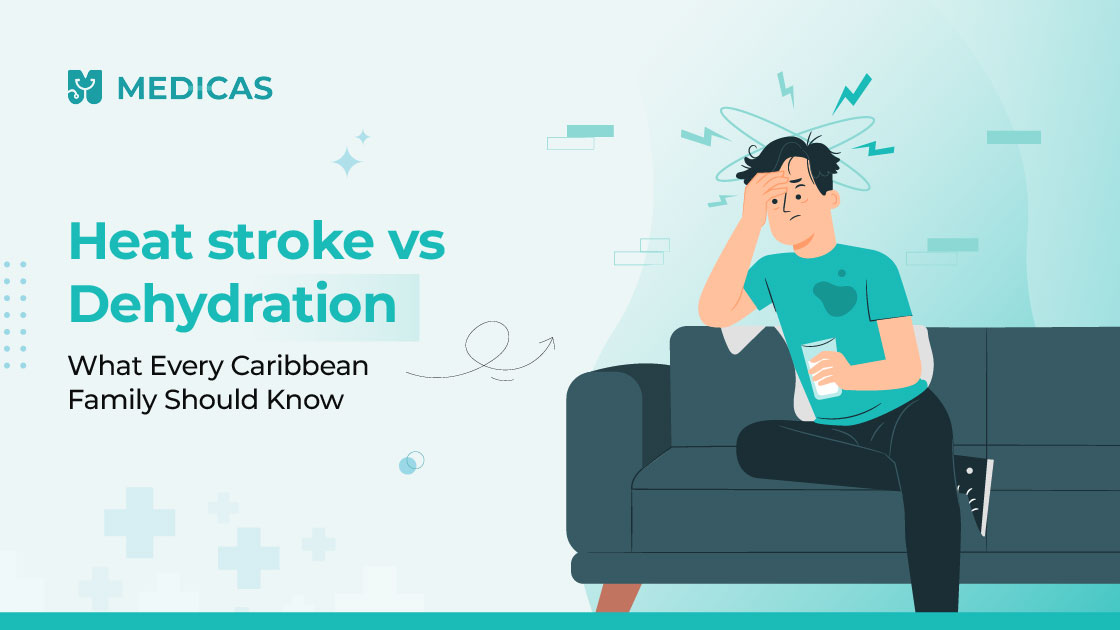Living in the Caribbean has its perks—sunshine, beaches, and a vibrant outdoor lifestyle. But with rising temperatures and high humidity, heat-related illnesses are a growing concern for families. One of the most important distinctions to understand is dehydration vs heatstroke. These conditions are often confusing, but knowing the variance can make all the difference in getting the right care, especially during peak summer months. This blog explores the key differences between heatstroke symptoms and signs of dehydration, why heat-related illness in the Caribbean is so common, and how to protect your loved ones.
Understanding the Basics: Heatstroke vs Dehydration
What Is Heatstroke?
Heatstroke is a serious and life-threatening condition that occurs when the body overheats and can no longer regulate its internal temperature. It’s the most severe form of heat-related illness and requires immediate medical attention. Key characteristics of heatstroke:
- Body temperature above 104°F (40°C)
- Altered mental state (confusion, agitation, seizures)
- Hot, dry, or flushed skin
- Rapid heartbeat and shallow breathing
- Possible unconsciousness
What Is Dehydration?
Dehydration happens when your body loses more fluids than it takes in, leading to a lack of water for normal body functions. It’s usually less severe than heatstroke but can escalate if left untreated. Common signs of dehydration include:
- Dry mouth and lips
- Dark yellow urine or reduced urination
- Dizziness or lightheadedness
- Fatigue or weakness
- Headache
Key Differences You Should Know
Understanding how to tell the difference between dehydration and heatstroke is essential:
- Dehydration can be managed at home in most cases with rest and rehydration.
- Heatstroke is a medical emergency—call for help immediately.
Think of dehydration as a warning sign. Left unchecked, it can progress to heat exhaustion and then to heatstroke. You can get an expert opinion on your sypmtoms via Medicas Online Doctor Consultation.
Symptoms to Watch for in Caribbean Heat
Common Heatstroke Symptoms
Because of the region’s climate, heat stroke symptoms in the Caribbean may come on quickly. Be on the lookout for:
- High body temperature
- Lack of sweating despite the heat
- Nausea or vomiting
- Rapid pulse
- Disorientation or confusion
- Seizures or coma (in extreme cases)
Signs of Dehydration
Milder but still dangerous, dehydration may manifest as:
- Thirst
- Sticky or dry mouth
- Dry, cool skin
- Muscle cramps
- Feeling faint
Heat Exhaustion vs. Heatstroke
Before full-blown heatstroke sets in, the body often passes through heat exhaustion. Symptoms include:
- Heavy sweating
- Pale skin
- Fast, weak pulse
- Muscle cramps
- Nausea and headache
These are early signs of heat exhaustion in kids and adults—treat them seriously to prevent progression.
Risk Factors in the Caribbean Climate
Why the Caribbean Increases Heat Illness Risk
The tropical environment means high year-round temperatures and humidity. Combined with outdoor activities, sun exposure, and sometimes limited access to shade or hydration, this creates the perfect storm for heat-related illness in the Caribbean.
At-Risk Groups: Children, Elderly, Outdoor Workers
Some populations are more vulnerable:
- Children: They may not recognize early symptoms or remember to hydrate.
- Elderly adults: Reduced thirst sensation and chronic health issues increase risk.
- Outdoor workers: Prolonged exposure and physical exertion make them highly susceptible.
Prevention Tips for Families
Staying Hydrated in Hot Weather
One of the best ways to prevent heat illnesses is by staying hydrated in hot weather:
- Drink water frequently—even if you don’t feel thirsty.
- Include electrolytes, especially during physical activity.
- Avoid sugary or alcoholic drinks which can worsen dehydration.
Clothing, Timing, and Shade
- Wear light, loose-fitting, breathable clothing.
- Plan outdoor activities during early morning or late afternoon.
- Take breaks in the shade and avoid direct sun for long periods.
Recognizing Early Warning Signs
Teach all family members to recognize the heat exhaustion symptoms and act fast:
- Encourage kids to speak up if they feel dizzy or tired.
- Watch for behavioral changes like irritability or sluggishness.
- Check for dry lips or absence of sweat in hot conditions.
What To Do: First Aid at Home
When It’s Dehydration
If someone shows signs of dehydration:
- Move them to a cool, shaded place.
- Offer water or an oral rehydration solution.
- Monitor their symptoms—if no improvement, consult a doctor.
Consult a doctor online or book a lab test if symptoms persist or worsen.
When It’s Heatstroke
If you suspect heatstroke:
- Call emergency services immediately.
- Move the person to a cooler area.
- Remove excess clothing and apply cool water to the skin.
- Fan air over the person while applying cold packs to neck, armpits, and groin.
- Do NOT give fluids if they are unconscious or disoriented.
When to See a Doctor Immediately
Seek urgent medical care if:
- Symptoms of confusion, high fever, or seizures occur.
- A child or elderly person shows signs of severe heat exhaustion.
- There’s no improvement after home care.
You can also book an appointment or speak to a psychologist if stress and physical symptoms overlap. Final Thoughts: Don’t Wait – Act Fast to Stay Safe In Caribbean climates, heat-related illnesses are common—but also preventable. Recognizing the signs early and taking fast action can save lives. Whether it’s staying hydrated in hot weather, modifying your routines, or knowing when to escalate to medical care, simple steps can protect your family. When in doubt, it’s always safer to get help. You can consult me directly via Medicas for mental health support related to physical stress, or speak with a doctor online for immediate medical concerns.
Frequently Asked Questions (FAQs)
- How do I know if it’s heatstroke or just dehydration?
Dehydration involves mild symptoms like thirst and fatigue, while heatstroke causes confusion, high fever, and loss of consciousness. If in doubt, treat it as an emergency.
- What are early signs of heat exhaustion in children?
Heavy sweating, crankiness, fatigue, nausea, and flushed skin. Act quickly to cool them down and hydrate.
- How can Caribbean families prevent heat-related illnesses?
Stay hydrated, avoid direct sunlight during peak hours, wear breathable clothing, and watch for early symptoms.
- When should I go to the hospital for heatstroke?
If there’s confusion, seizures, high fever, or unconsciousness—go to the hospital immediately.
- Is heat exhaustion the same as dehydration?
Not exactly. Dehydration can lead to heat exhaustion, which is more serious and can progress to heatstroke if untreated.
Disclaimer
Medical Advice: The information provided in this blog post is for educational purposes only and should not be considered as a substitute for professional medical advice, diagnosis, or treatment. Always consult with a qualified healthcare professional for personalized guidance regarding your specific medical condition.
Accuracy of Information: While we strive to provide accurate and up-to-date information, the field of medicine and viral fevers is constantly evolving. The content in this blog post may not reflect the most current research or medical guidelines. Therefore, it is advisable to cross-check any information provided with reliable sources or consult a healthcare professional.
Individual Variations: The symptoms, causes, treatment options, and preventive measures discussed in this blog post are general in nature and may not apply to everyone. It is important to remember that each individual’s situation is unique, and personalized medical advice should be sought when making healthcare decisions.
External Links: This blog post may contain links to external websites or resources for additional information. However, we do not endorse or have control over the content of these third-party websites. Accessing these links is done at your own risk, and we are not responsible for any consequences or damages that may arise from visiting these external sources.
Results May Vary: The effectiveness of treatment options or preventive measures mentioned in this blog post may vary from person to person. What works for one individual may not work the same way for another. It is essential to consult with a healthcare professional for personalized advice tailored to your specific needs.

Mr. Leroy Lewis is a holistic psychologist with over 14 years of experience in counselling and mental health care. Based in Chaguanas, Trinidad and Tobago, he is committed to helping individuals overcome emotional challenges and achieve personal growth. With a Master’s in Counselling Psychology and extensive training in trauma, addiction, and employee assistance programs, he blends clinical insight with a compassionate, client-centred approach.


